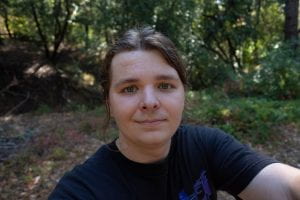
As part of a collaboration between RED² Laboratory and Stanford Linear Accelerator Center (SLAC), Ph.D. student, Andrew Rosenstrom is onsite at SLAC investigating new applications of high energy accelerator physics with new modalities in FLASH radiotherapy.
Catch up with Andrew as he describes his exciting research activities at SLAC.
- Please describe your project(s) work you conducted in the RED² Laboratory. Include any details on the scientific/technical challenges you were tasked with addressing and limitations on current approaches that prompted your investigation.
My work as a part of the RED² group is to design and optimize FLASH radiotherapy components for a preclinical system to inform radiation biology research and design parameters for a clinical FLASH radiotherapy device. The FLASH radiotherapy system in question uses high energy bremsstrahlung radiation (>10 MeV) while previous photon-driven FLASH systems have used photon energies <250 keV. Due to the higher photon energies and high workload, adverse secondary radiation, photoneutrons and capture gamma rays, are generated with relatively high fluences compared to radiotherapy machines that use conventional dose rates; shielding methodologies are needed to efficiently shield the primary and secondary radiation from preclinical and clinical FLASH radiotherapy machines to minimize extraneous doses to the patient, the operator and the public. Additionally, collimator components, which shape the photon beam and subsequently, the dose distribution in the sample, need to be optimized to meet certain experimental criteria while maximizing the dose rate in the desired region. By increasing the dose rate as high as possible, the experimenters will have greater flexibility to perform experiments in order to understand the underlying biological mechanisms of the FLASH effect.
2. What scientific/technical tools/methods did you use/learn to conduct your investigation?
My work deals primarily with Monte Carlo radiation transport using the code FLUKA. As a part of my work, I have continued to gain proficiency in conducting efficient and accurate simulations as well as more complex aspects of radiation transport through the use of FLUKA’s user-routines.
In order to perform the optimization of the beam shaping components of the collimator, I have learned how to use heuristic methods, namely Genetic and Nelder-Mead simplex search algorithms, as well as how to address the challenges faced by algorithms in optimization: proving optimality, completeness of the search, proving accuracy and precision of results, and computational efficiency.
3. What non-technical skills did you develop as a result of your experiences? Did you present at any conferences/win any awards?
Through my work, I have greatly improved my presentation skills, both speaking and slide design, performing weekly presentations with my research group. I have also presented my work at several conferences and have won second place at the Texas HPS conference.

4. What do you believe will be the impact of your work – scientifically? In your academic goals?
I believe my work will help to inform the design of clinical FLASH machines that use high energy bremsstrahlung radiation to deliver dose. Beyond radiation protection, the work involving FLASH radiotherapy has the potential to provide better patient outcomes and expanded access for external beam radiotherapy treatments.
5. Looking ahead, what are your professional and/or technical goals?
My long-term professional goal is to become the Radiation Safety Officer of a national laboratory. This role would require technical proficiency, and intuition for all aspects of radiation protection systems. Being in this role at a national laboratory would provide access to cutting edge applications that involve radiation and would be very exciting as well as a real challenge.

